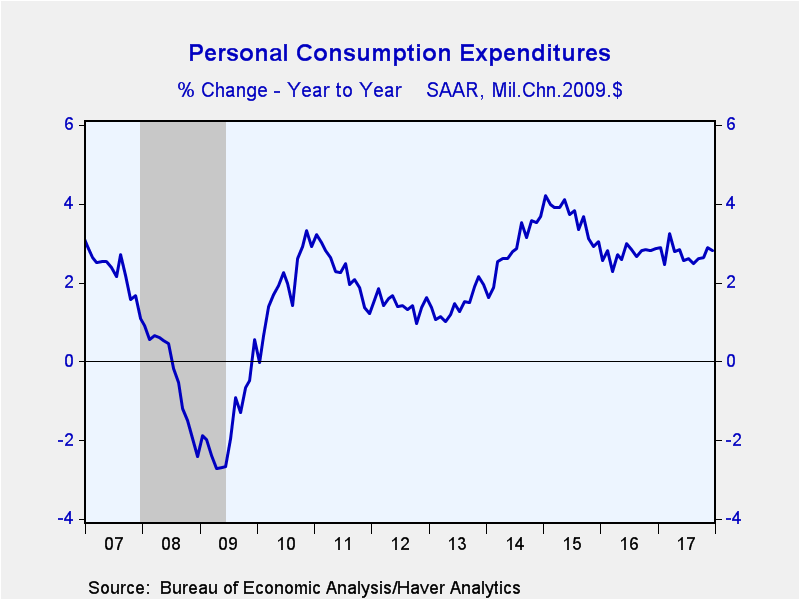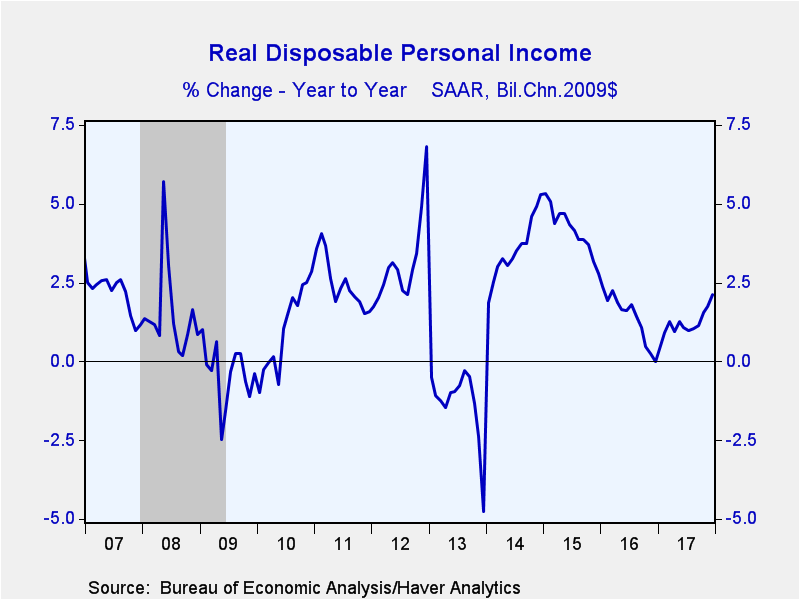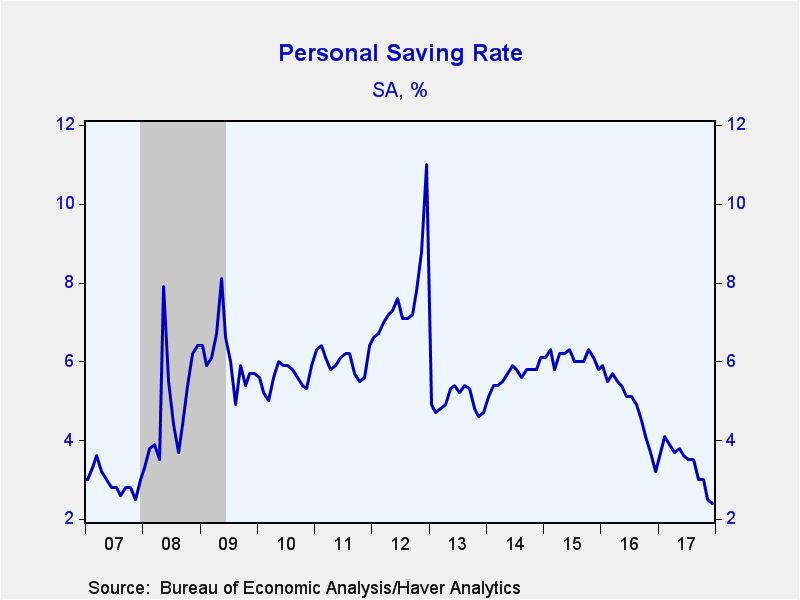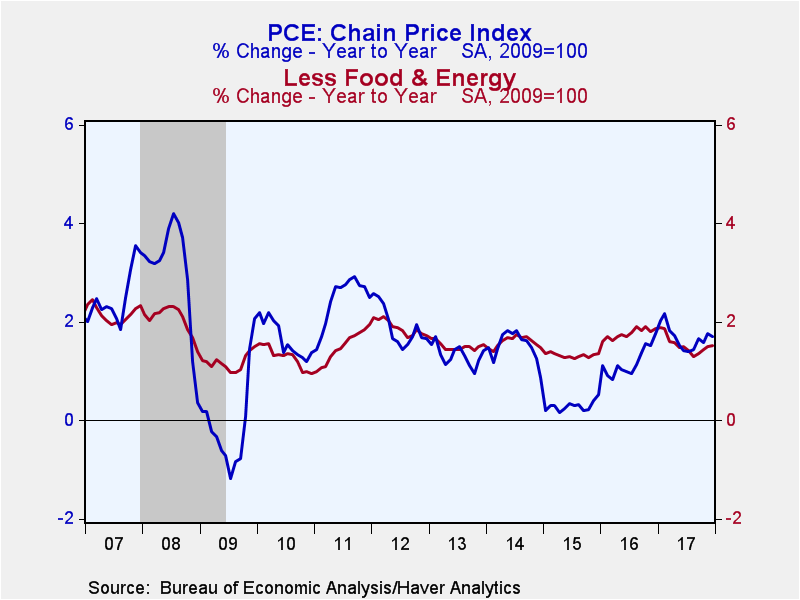 Global| Jan 29 2018
Global| Jan 29 2018U.S. Personal Spending Outpaces Income
by:Tom Moeller
|in:Economy in Brief
Summary
Individuals extended the recent buying trend and dipped into savings last month. Personal consumption expenditures increased 0.4% (4.6% y/y) during December following a 0.8% November rise, revised from 0.6%. A 0.4% improvement had [...]
Individuals extended the recent buying trend and dipped into savings last month. Personal consumption expenditures increased 0.4% (4.6% y/y) during December following a 0.8% November rise, revised from 0.6%. A 0.4% improvement had been expected in the Action Economics Forecast Survey. During all of last year, spending increased 4.5%, the strongest gain since 2011. Adjusted for price inflation, personal spending increased 0.3% (2.8% y/y) after a 0.5% gain. Real durable goods purchases strengthened 0.8% (7.3% y/y) after a 1.1% rise. Motor vehicle buying increased 1.0% (2.7% y/y) after a 1.3% decline. Real spending on home furnishings & appliances rose 0.9% (10.1% y/y) after three consecutive months of even stronger increase. Real spending on recreational goods & vehicles gained 0.3% (10.0% y/y) following a 3.5% jump. Constant dollar spending on nondurable items eased slightly (+3.3% y/y) after a 1.0% surge. Real purchases of clothing & footwear improved 0.3% (5.2% y/y) on the heels of a 2.9% increase. Spending on gasoline & oil declined 1.1% (-3.6% y/y) after a 0.1% slip. Real spending on food & beverages rose 0.4% (3.7% y/y) following a 0.9% jump. Real spending on services gained 0.3% (2.0% y/y), the same as in November. Real recreation spending increased 0.2% (1.5% y/y) after a 1.0% jump. Real health care outlays nudged 0.1% higher (2.5% y/y) following a 0.3% rise, while housing & utilities expenditures improved 0.5% (1.2% y/y), the strongest gain in nine months.
Personal income rose 0.4% (4.1% y/y) last month following an unrevised 0.3% November gain. A 0.3% rise had been expected. During all of last year income rose 3.1%. Wages & salaries rose 0.5% following a 0.4% increase. Growth from December-to-December rose to 4.9% from 0.8% in 2016. Rental income improved 0.4% (5.8% y/y) after a 0.5% rise. Proprietors' income eased 0.1% (+3.7% y/y) following a 0.9% jump. Interest income surged 1.2% (5.0% y/y) for the third consecutive month. Dividend income eased 0.1% (+2.7% y/y) following a 0.6% decline. Personal transfer receipts held steady (2.8% y/y) after a 0.4% decline. Social Security payments increased 0.5% (3.4% y/y) after a 0.8% decline. Medicare payments gained a steady 0.3% (2.9% y/y), but veterans benefits fell 0.6% (+5.9% y/). Unemployment insurance benefits rose 0.4% (-8.8% y/y) following a 1.1% increase.
Disposable income gained 0.3% (3.9% y/y) for the third straight month. Adjusted for price changes, take-home pay improved 0.2% after m/m stability. The December-to-December increase of 2.1% was improved from roughly no change during 2016.
The personal savings rate declined to 2.4%, the lowest level since September 2005. Personal saving declined by 20.6% y/y.
The PCE chain-type price index improved 0.1% (1.7% y/y) after a 0.2% rise. Excluding food & energy, prices rose 0.2% (1.5% y/y) following a 0.1% gain. Nondurable goods prices fell 0.2% (+1.4% y/y) with a 2.2% drop (+10.7% y/y) in gasoline & energy prices. That followed a 7.0% gain. Durable goods prices added to the decline with a 0.1% slip (-1.7% y/y) after a 0.2% drop. The price index for recreational goods & vehicles fell 0.6% (-3.0% y/y) while motor vehicle costs rose 0.7% (-0.3% y/y). Services prices improved 0.2% (2.3% y/y) for a second straight month.
The personal income & consumption figures are available in Haver's USECON database with detail in the USNA database. The Action Economics figure is in the AS1REPNA database.
| Personal Income & Outlays (%) | Dec | Nov | Oct | Dec Y/Y | 2017 | 2016 | 2015 |
|---|---|---|---|---|---|---|---|
| Personal Income | 0.4 | 0.3 | 0.4 | 4.1 | 3.1 | 2.4 | 5.0 |
| Wages & Salaries | 0.5 | 0.4 | 0.2 | 4.9 | 3.1 | 2.9 | 5.1 |
| Disposable Personal Income | 0.3 | 0.3 | 0.3 | 3.9 | 2.9 | 2.6 | 4.5 |
| Personal Consumption Expenditures | 0.4 | 0.8 | 0.3 | 4.6 | 4.5 | 4.0 | 3.9 |
| Personal Saving Rate | 2.4 | 2.5 | 3.0 | 3.2 (Dec.'16) |
3.4 | 4.9 | 6.1 |
| PCE Chain Price Index | 0.1 | 0.2 | 0.1 | 1.7 | 1.7 | 1.2 | 0.3 |
| Less Food & Energy | 0.2 | 0.1 | 0.2 | 1.5 | 1.5 | 1.8 | 1.3 |
| Real Disposable Income | 0.2 | 0.0 | 0.2 | 2.1 | 1.2 | 1.4 | 4.2 |
| Real Personal Consumption Expenditures | 0.3 | 0.5 | 0.1 | 2.8 | 2.7 | 2.7 | 3.6 |
Tom Moeller
AuthorMore in Author Profile »Prior to joining Haver Analytics in 2000, Mr. Moeller worked as the Economist at Chancellor Capital Management from 1985 to 1999. There, he developed comprehensive economic forecasts and interpreted economic data for equity and fixed income portfolio managers. Also at Chancellor, Mr. Moeller worked as an equity analyst and was responsible for researching and rating companies in the economically sensitive automobile and housing industries for investment in Chancellor’s equity portfolio. Prior to joining Chancellor, Mr. Moeller was an Economist at Citibank from 1979 to 1984. He also analyzed pricing behavior in the metals industry for the Council on Wage and Price Stability in Washington, D.C. In 1999, Mr. Moeller received the award for most accurate forecast from the Forecasters' Club of New York. From 1990 to 1992 he was President of the New York Association for Business Economists. Mr. Moeller earned an M.B.A. in Finance from Fordham University, where he graduated in 1987. He holds a Bachelor of Arts in Economics from George Washington University.










